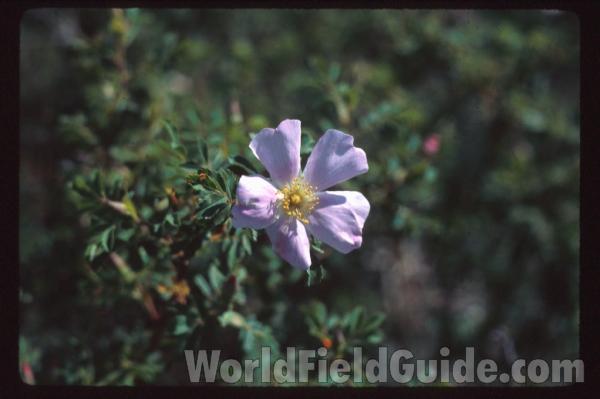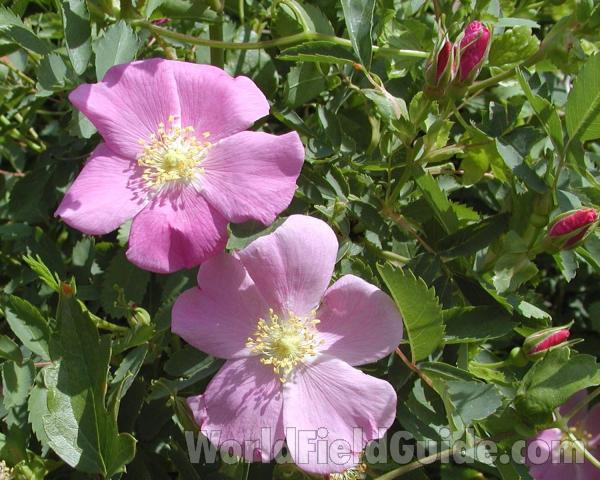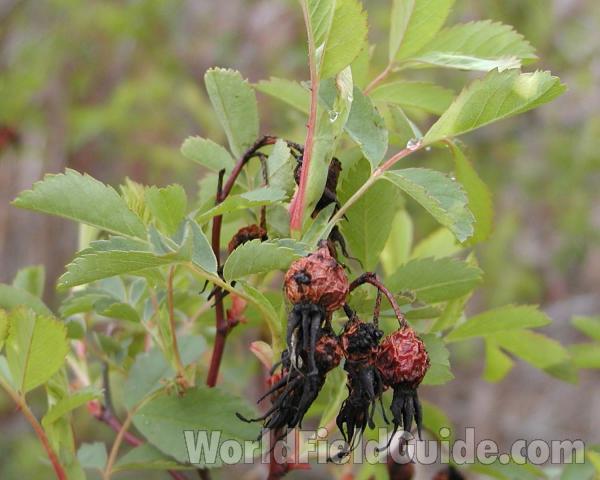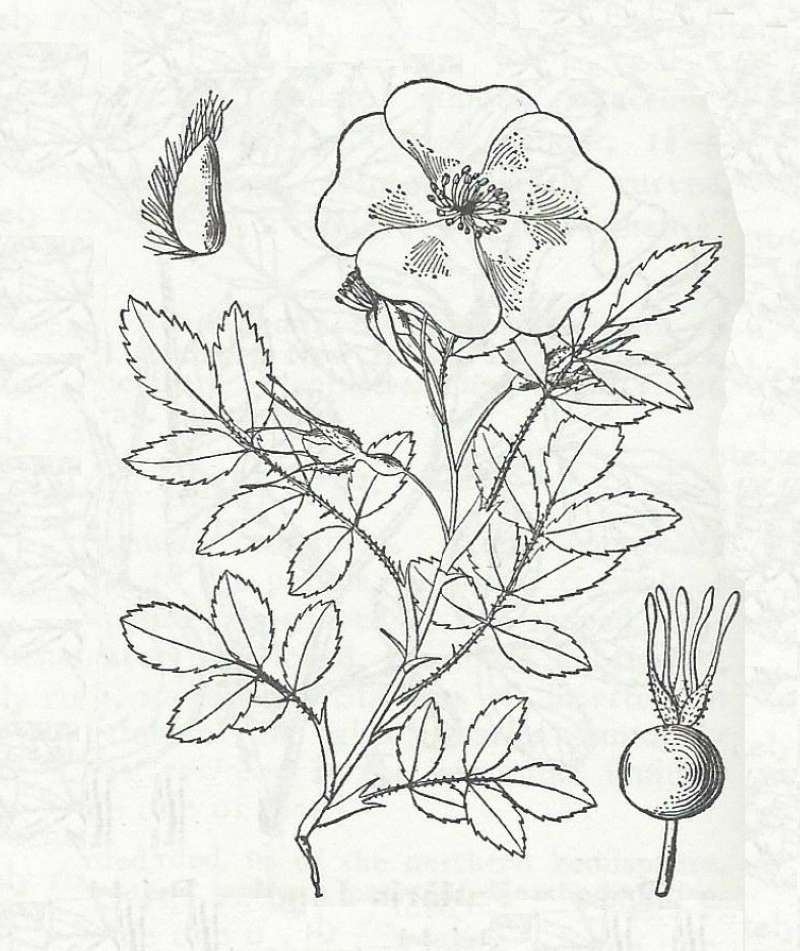SPECIES INFO
Woods rose or western rose (Rosa woodsii) is found from Minnesota to Missouri and south to New Mexico and Colorado. This is also found north into Canada as far north as the Northwest Territory. This can be found as far south as northern California. This plant can reach to 3 feet in height. Although the lower branches are armed with straight spines, the upper branches can be without spines. The leaflets are in groups of 5-9. The petals are pink, but rarely can be white.
The varieties gratissima and glabrata can be found as far south as the San Bernardino Mountains in southern California.Rosa genus (roses) is a large genus of about 100 to 150 species of the northern hemisphere. Many species in this genus are planted as garden ornamentals, and several species are valuable for the fruits which are high in vitamin C. There are numerous hybrids, many of uncertain origin, available in the garden trade. Kartesz lists 49 species, eight hybrids, and 39 subspecies as being found in his greater North America, including the United States, Canada, Hawaii, Greenland, Puerto Rico and the U.S. Virgin Islands.
Most species have thorns, spines, or prickles on their stems. The stems are erect, arching, or sometimes climbing. The usually alternate leaves are frequently divided into an odd number of toothed leaflets. The flowers (wild forms) usually have five petals. The red or orange fruits (called hips) are usually multi-seeded.
Rose Family has been arbitrarily divided into several different parts to facilitate study. This portion contains the small wild plants in the family. Included herein are wild roses, strawberries, raspberries, and other related plants. (The rose hybrids, Spiraea, and fruit trees are the other sections created to study this large family.)
Rose Family (Rosaceae) of the Rose Order contains the Rose genus and is a very large diverse family containing not only the roses, but many small weeds and also the important fruit trees including the apple, cherry, pear, and plum. Along with the Grass and Legume Families, this family is one of the most important of all plant groups. There are over 3,000 species in this family organized into over 100 different genera. There are over 840 species growing in greater North America. Typical flowers in this family have five petals and five sepals.
Here the family is divided as follows:
A) Miscellaneous small wild plants such as roses, strawberries, et cetera
B) Rose hybrids of interest to the flower gardener
C) Spiraea group (which forms a natural subfamily)
D) Fruit trees and hawthorns, etceteras (Further redivided)
Crataegeae (Crataegus, Cotoneaster)
Pruneae (Cherries, Plums, Peaches)
Malea (Apples, Pears, Mountain Ash)
Rose Group (Order Rosales) contains many large and very important families. Included here are fruit trees in the family Rosaceae, the nitrogen fixing plants like clover and alfalfa (in the family Leguminosae), and a large assemblage of plants divided into over fifteen different families.
There has been considerable research in recent years as to the organization of the various plant families into orders. Although we certainly recognize and applaud those who are rearranging the families, we are staying with a more traditional approach for several reasons:
1) The traditional approach is well known, and still exists in many very popular field guides.
2) There are questions as to whether the new organizations are finalized.
3) We recognize there are essentially two different modern systems today: A European one and a North American one.
4) Furthermore, we recognize that most plant families and their boundaries are unchanged. In fact many excellent modern books present the families within the Monocots in a simple alphabetical sequence and the families within the Dicots in a simple alphabetical sequence.
Dicots (Dicotyledoneae Class) are the predominant group of vascular plants on earth. With the exception of the grasses (Monocots) and the Conifers (Gymnosperms), most of the larger plants that one encounters are Dicots. Dicots are characterized by having a seed with two outer shell coverings.
Some of the more primitive Dicots are the typical hardwood trees (oaks, birches, hickories, etc). The more advanced Dicots include many of the Composite (Aster) Family flowers like the Dandelion, Aster, Thistles, and Sunflowers. Although many Monocots reach a very high degree of specialization, most botanists feel that the Dicots represent the most advanced group of plants.
Seed plants (Phylum Embryophyta) are generally grouped into one large phylum containing three major classes: the Gymnosperms, the Monocots, and the Dicots. (Some scientists separate the Gymnosperms into a separate phylum and refer to the remaining plants as flowering plants or Angiospermae.)
For North American counts of the number of species in each genus and family, the primary reference has been John T. Kartesz, author of A Synonymized Checklist of the Vascular Flora of the United States, Canada, and Greenland (1994). The geographical scope of his lists include, as part of greater North America, Hawaii, Alaska, Greenland, Puerto Rico, and the Virgin Islands.
Kartesz lists 21,757 species of vascular plants comprising the ferns, gymnosperms and flowering plants as being found in greater North America (including Alaska, Hawaii, Greenland, Puerto Rico and the Virgin Islands.
There are estimates within the scientific world that about half of the listed North American seed plants were originally native with the balance being comprised of Eurasian and tropical plants that have become established.
Plant kingdom contains a large variety of different organisms including mosses, ferns, and seed plants. Most plants manufacture their energy from sunlight and water. Identification of many species is difficult in that most individual plants have characteristics that have variables based on soil moisture, soil chemistry, and sunlight.
Because of the difficulty in learning and identifying different plant groups, specialists have emerged that study only a limited group of plants. These specialists revise the taxonomy and give us detailed descriptions and ranges of the various species. Their results are published in technical journals and written with highly specialized words that apply to a specific group.
On the other hand, there are the nature publishers. These people and companies undertake the challenging task of trying to provide easy to use pictures and descriptions to identify those species.






